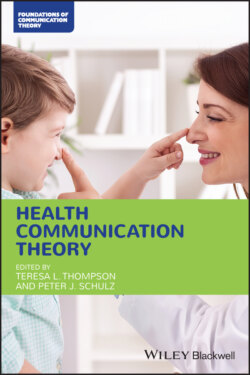Читать книгу Health Communication Theory - Группа авторов - Страница 26
Health Literacy
ОглавлениеAnother concept that merits attention in the development of social marketing campaigns and health promotion programs is health literacy, a set of characteristics that allow for the understanding and use of health information to make health decisions (Aldoory 2017). Berkman and colleagues (Berkman, Davis, and McCormack 2010) conducted a review of 13 definitions of health literacy and then proposed a new definition: the degree to which individuals can obtain, process, understand, and communicate about health‐related information needed to make informed health decisions. Given this definition, it is no surprise that lower health literacy is linked to poorer health outcomes and substantial increased costs to the overall health care system (Nielsen‐Bohlman, Panzer, and Kindig 2004; Paasche‐Orlow and Wolf 2007). Paasche‐Orlow and Wolf (2007) developed a framework to demonstrate the causal pathways between limited health literacy and patients’ health outcomes. It is estimated that between one third to one half of US adults have limited health literacy (Nielsen‐Bohlman et al. 2004).
Given the evolution of the concept of health literacy, which was initially strongly tied to math and reading capabilities in the health context, one of the most frequent areas of health communication research focused on health literacy has been around the readability of various kinds of health promotion materials. Weiss (2015) noted that in a search of medical literature from 2000 to 2013 there were at least 160 studies investigating readability of patient education materials, and argued that the consistent finding – the reading demand of patient materials is too high – is well‐established and research should focus on more productive avenues. Other studies have considered everything from informed consent documents (Donovan‐Kicken, Mackert, Guinn, et al. 2012) to patient–provider communication (Hironaka and Paasche‐Orlow 2008) to approaches for improving medication instructions (Katz, Kripalani, and Weiss 2006) to how advertising and journalism professionals understand health literacy (Hinnant and Len‐Rios 2009; Mackert 2011). Finally, in a thoughtful study, Meppelink and colleagues (2015) make the important point that all individuals regardless of their health literacy level benefit from simpler, clearer messages – a universal precautions approach. There is both a solid foundation on which to build regarding the role of health literacy in health communication and social marketing efforts, as well as substantial room for improving the field’s understanding the mechanisms of health literacy on eventual outcomes.
Those interested in health literacy as an individual‐level variable that can affect the potential impact of social marketing efforts and contribute to overall health face several challenges. As already noted, there is a variety of definitions of health literacy, and the different definitions can create confusion and a lack of consensus within the field (Mackert, Champlin, Su, and Guadagno 2015); a recent proposal by the US Department of Health and Human Services to adopt a new definition of health literacy which would emphasize the role of society in providing accessible and comprehensible health information has some potential benefits (e.g. increasing the focus on those delivering health information) but could also exacerbate some of the challenges of a lack of consensus around the definition of health literacy (e.g. the indexing of academic literature focused on health literacy; Ancker, Grossman, and Benda 2019). It is perhaps a natural consequence of lack of consensus around definitions which leads to a host of measures around health literacy, as well as accompanying calls for consensus and better measures of health literacy that reflect newer perspectives on health literacy as an avenue for health promotion (Pleasant, Cabe, Patel, et al. 2015; Pleasant, McKinney, and Rikard 2011). Perhaps the most pressing issue is that there is limited, quality evidence about what kind of interventions can change the negative outcomes associated with limited health literacy (Berkman, Sheridan, Donahue, et al. 2011; Weiss 2015). Focused research on the different steps of building health promotion efforts – from the message design process to audience reception to health outcomes – with health literacy as a consideration throughout the process will contribute to a growing evidence based of how best to build health literacy and improve the health of those with limited health literacy. Aldoory (2017) lays out a number of existing research gaps and opportunities for future research related to health literacy and health communication. With a discussion of health literacy behind us, we next turn to locus of control by defining the concept and dimensions, as well as discussing how it provides opportunities and challenges to health practitioners.
